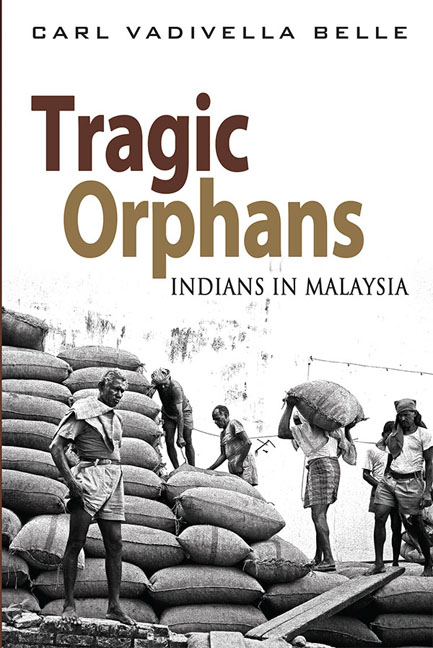Book contents
- Frontmatter
- Contents
- Acknowledgements
- List of Abbreviations
- Introduction
- 1 The Malay Peninsula: Early History, Melaka and the Colonial Setting
- 2 European Colonialism and the Malay Peninsula
- 3 India and the Development of British Ideologies of Empire
- 4 British Governance of Malaya
- 5 Slavery and Indentured Labour
- 6 Indian Indentured Labour in Malaya
- 7 Kangany Labour in Malaya
- 8 Other Indian Immigration
- 9 Indian Political Development to 1941
- 10 The Japanese Invasion, Subhas Chandra Bose and Indian Wartime Nationalism
- 11 The Post–war Period: Reform and Repression: 1945–48
- 12 From Federation to Merdeka
- 13 From Malaya to Malaysia: Singapore, 13 May and the New Economic Policy
- 14 The Mahathir Years: A Changing Malaysian Landscape
- 15 Abdullah Badawi, Islamization, and the Rise of Hindraf
- 16 Najib and 1Malaysia: A New Deal?
- Conclusions
- Bibliography
- Index
7 - Kangany Labour in Malaya
Published online by Cambridge University Press: 06 June 2017
- Frontmatter
- Contents
- Acknowledgements
- List of Abbreviations
- Introduction
- 1 The Malay Peninsula: Early History, Melaka and the Colonial Setting
- 2 European Colonialism and the Malay Peninsula
- 3 India and the Development of British Ideologies of Empire
- 4 British Governance of Malaya
- 5 Slavery and Indentured Labour
- 6 Indian Indentured Labour in Malaya
- 7 Kangany Labour in Malaya
- 8 Other Indian Immigration
- 9 Indian Political Development to 1941
- 10 The Japanese Invasion, Subhas Chandra Bose and Indian Wartime Nationalism
- 11 The Post–war Period: Reform and Repression: 1945–48
- 12 From Federation to Merdeka
- 13 From Malaya to Malaysia: Singapore, 13 May and the New Economic Policy
- 14 The Mahathir Years: A Changing Malaysian Landscape
- 15 Abdullah Badawi, Islamization, and the Rise of Hindraf
- 16 Najib and 1Malaysia: A New Deal?
- Conclusions
- Bibliography
- Index
Summary
In Chapter 6 we noted that the form of recruitment known as the “kangany system” had become firmly established in Malayan plantations well before the abolition of indenture in 1910. The Sanderson Report of that year had commented that an increasing proportion of the estate workforce was being recruited under the kangany system, and had observed that this form of recruitment generally produced a more reliable and stable workforce than that obtained under indenture. The Committee had also commented that while kangany labour was popular with coffee and rubber planters, sugar planters were resolutely opposed to the system.
Kangany recruitment entered Malaya via Ceylon where it had been successfully used to procure labour for European-owned coffee estates. While a handful of Malayan planters had experimented with kangany labour in the early 1860s, the system did not achieve broad acceptance until the establishment of coffee plantations in the 1880s and 1890s. The introduction of rubber to the Peninsula in the 1890s coincided with a protracted downturn in coffee prices, and encouraged many coffee planters to convert their estates to the new crop with the consequence that rubber rapidly became the leading plantation crop in Malaya. In 1909–10 rubber entered a prolonged boom period. Rubber estates were invariably staffed by kangany labour. Until the abandonment of indenture, the two systems of immigration — indenture and kangany — ran parallel, with coffee and rubber planters importing kangany labour and sugar planters preferring indentured labour.
What was the kangany system? The term originates from the Tamil kankani, meaning owner or foreman. It is a word that connotes some degree of power and respect. Kanganies were “coolies of standing” who not only recruited labour to work on estates, but as field foremen (“headmen”) undertook to supervise those whom they had recruited. The kangany came from a non-Brahman “clean” (that is, non-polluting) caste, almost always drawn from the Vanniyar, Kallar or Goundar castes,8 and preferably headed a large family. He was a man who enjoyed a reputation for probity and fairness in his dealings, and who thus could be expected to command respect within his home taluk (district).
- Type
- Chapter
- Information
- Tragic OrphansIndians in Malaysia, pp. 103 - 135Publisher: ISEAS–Yusof Ishak InstitutePrint publication year: 2014



